

Compact Muon Solenoid
LHC, CERN
| CMS-B2G-16-007 ; CERN-EP-2017-077 | ||
| Combination of searches for heavy resonances decaying to WW, WZ, ZZ, WH, and ZH boson pairs in proton-proton collisions at $\sqrt{s} = $ 8 and 13 TeV | ||
| CMS Collaboration | ||
| 25 May 2017 | ||
| Phys. Lett. B 774 (2017) 533 | ||
| Abstract: A statistical combination of searches is presented for massive resonances decaying to WW, WZ, ZZ, WH, and ZH boson pairs in proton-proton collision data collected by the CMS experiment at the LHC. The data are taken at centre-of-mass energies of 8 and 13 TeV, corresponding to respective integrated luminosities of 19.7 and up to 2.7 fb$^{-1}$. The results are interpreted in the context of heavy vector triplet and singlet models that mimic properties of composite-Higgs models predicting W' and Z' bosons decaying to WZ, WW, WH, and ZH bosons. A model with a bulk graviton that decays into WW and ZZ is also considered. This is the first combined search for WW, WZ, WH, and ZH resonances and yields lower limits on masses at 95% confidence level for W' and Z' singlets at 2.3 TeV, and for a triplet at 2.4 TeV. The limits on the production cross section of a narrow bulk graviton resonance with the curvature scale of the warped extra dimension $\tilde{k}= $ 0.5, in the mass range of 0.6 to 4.0 TeV, are the most stringent published to date. | ||
| Links: e-print arXiv:1705.09171 [hep-ex] (PDF) ; CDS record ; inSPIRE record ; CADI line (restricted) ; | ||
| Figures | |

png pdf |
Figure 1:
Exclusion limits at 95% CL for HVT models A (left) and B (right) on the signal strengths for the singlets $\mathrm{W}' \to \mathrm{ W } \mathrm{ Z } $ and $\mathrm{ W } \mathrm{ H } $ (upper), and $\mathrm{Z}' \to \mathrm{ W } \mathrm{ W } $ and $\mathrm{ Z } \mathrm{ H } $ (lower) as a function of the resonance mass, obtained by combining the 8 and 13 TeV analyses. The signal strength is defined as the ratio of the excluded cross section and the theoretical prediction. The curves with symbols refer to the different inputs to the combinations. The thick solid (dashed) line represents the combined observed (expected) limits. |
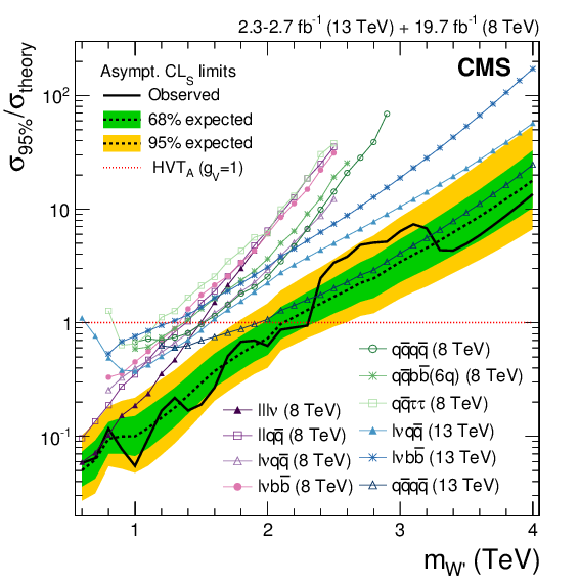
png pdf |
Figure 1-a:
Exclusion limits at 95% CL for HVT model A on the signal strengths for the singlet $\mathrm{W}' \to \mathrm{ W } \mathrm{ Z } $ and $\mathrm{ W } \mathrm{ H } $ as a function of the resonance mass, obtained by combining the 8 and 13 TeV analyses. The signal strength is defined as the ratio of the excluded cross section and the theoretical prediction. The curves with symbols refer to the different inputs to the combinations. The thick solid (dashed) line represents the combined observed (expected) limits. |
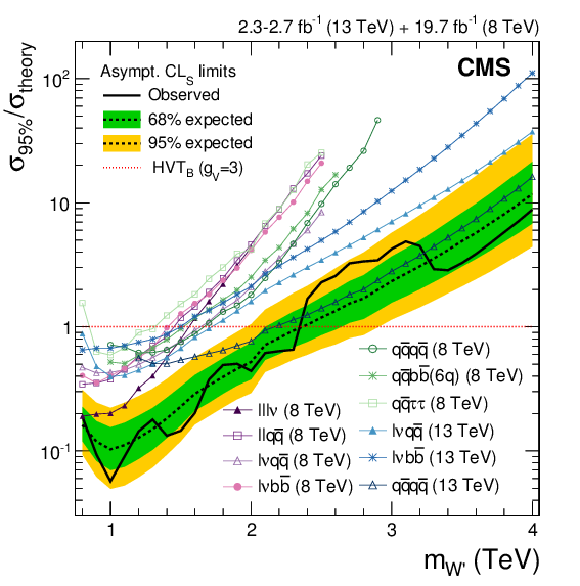
png pdf |
Figure 1-b:
Exclusion limits at 95% CL for HVT model B on the signal strengths for the singlet $\mathrm{W}' \to \mathrm{ W } \mathrm{ Z } $ and $\mathrm{ W } \mathrm{ H } $ as a function of the resonance mass, obtained by combining the 8 and 13 TeV analyses. The signal strength is defined as the ratio of the excluded cross section and the theoretical prediction. The curves with symbols refer to the different inputs to the combinations. The thick solid (dashed) line represents the combined observed (expected) limits. |
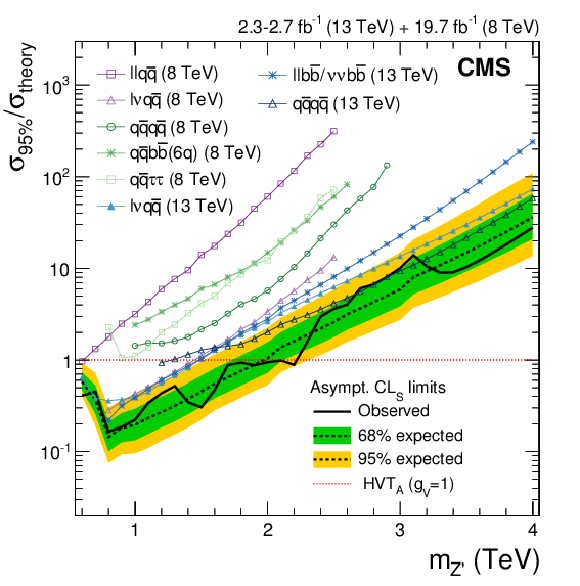
png pdf |
Figure 1-c:
Exclusion limits at 95% CL for HVT model A on the signal strengths for the singlet $\mathrm{Z}' \to \mathrm{ W } \mathrm{ W } $ and $\mathrm{ Z } \mathrm{ H } $ as a function of the resonance mass, obtained by combining the 8 and 13 TeV analyses. The signal strength is defined as the ratio of the excluded cross section and the theoretical prediction. The curves with symbols refer to the different inputs to the combinations. The thick solid (dashed) line represents the combined observed (expected) limits. |
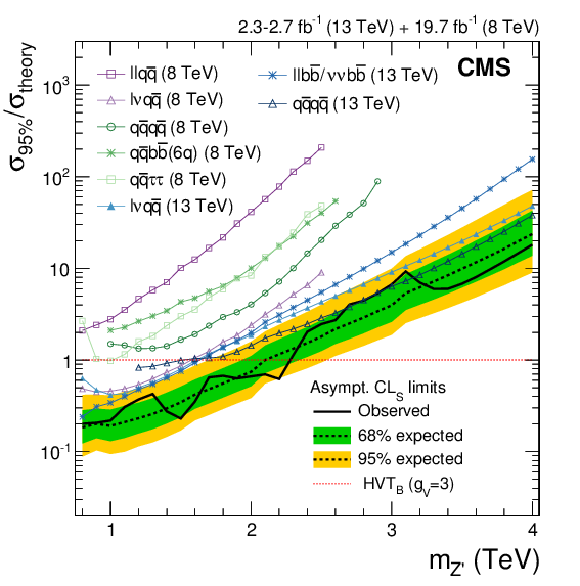
png pdf |
Figure 1-d:
Exclusion limits at 95% CL for HVT model B on the signal strengths for the singlet $\mathrm{Z}' \to \mathrm{ W } \mathrm{ W } $ and $\mathrm{ Z } \mathrm{ H } $ as a function of the resonance mass, obtained by combining the 8 and 13 TeV analyses. The signal strength is defined as the ratio of the excluded cross section and the theoretical prediction. The curves with symbols refer to the different inputs to the combinations. The thick solid (dashed) line represents the combined observed (expected) limits. |

png pdf |
Figure 2:
Exclusion limits at 95% CL on the signal strengths in HVT models A (upper left) and B (upper right) for the triplet V', as a function of the resonance mass, obtained by combining the 8 and 13 TeV diboson searches. The signal strength is defined as the ratio of the excluded cross section and the theoretical prediction. In the upper plots, the curves with symbols refer to the different inputs to the combination. The thick solid (dashed) line represents the combined observed (expected) limits. In the lower plot, exclusion regions in the plane of the HVT-model couplings ($g_\mathrm {V}c_{\mathrm{ H } }$, $g^2c_\mathrm {F}/g_\mathrm {V}$ ) for three resonance masses of 1.5, 2.0, and 3.0 TeV, where $g$ denotes the weak gauge coupling. The points A and B of the benchmark models used in the analysis are also shown. The boundaries of the regions excluded in this search are indicated by the solid, dashed, and dashed-dotted lines. The areas indicated by the solid shading correspond to regions where the resonance width is predicted to be more than 5% of the resonance mass, in which the narrow-resonance assumption is not satisfied. |
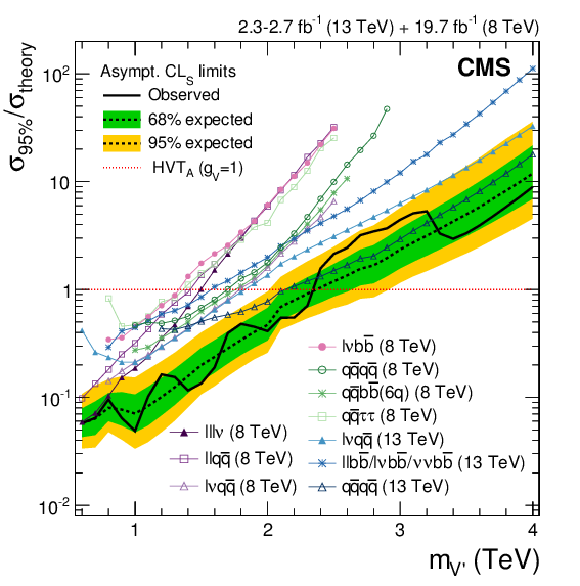
png pdf |
Figure 2-a:
Exclusion limits at 95% CL on the signal strengths in HVT model A for the triplet V', as a function of the resonance mass, obtained by combining the 8 and 13 TeV diboson searches. The signal strength is defined as the ratio of the excluded cross section and the theoretical prediction. In the upper plots, the curves with symbols refer to the different inputs to the combination. The thick solid (dashed) line represents the combined observed (expected) limits. |

png pdf |
Figure 2-b:
Exclusion limits at 95% CL on the signal strengths in HVT model B for the triplet V', as a function of the resonance mass, obtained by combining the 8 and 13 TeV diboson searches. The signal strength is defined as the ratio of the excluded cross section and the theoretical prediction. In the upper plots, the curves with symbols refer to the different inputs to the combination. The thick solid (dashed) line represents the combined observed (expected) limits. |
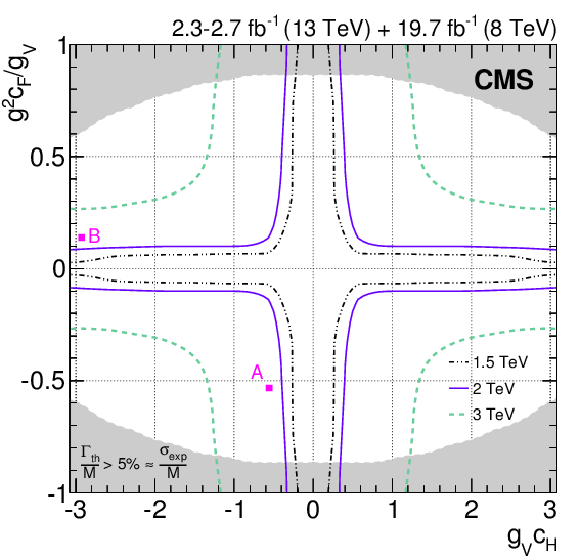
png pdf |
Figure 2-c:
In this plot, exclusion regions in the plane of the HVT-model couplings ($g_\mathrm {V}c_{\mathrm{ H } }$, $g^2c_\mathrm {F}/g_\mathrm {V}$ ) for three resonance masses of 1.5, 2.0, and 3.0 TeV, where $g$ denotes the weak gauge coupling. The points A and B of the benchmark models used in the analysis are also shown. The boundaries of the regions excluded in this search are indicated by the solid, dashed, and dashed-dotted lines. The areas indicated by the solid shading correspond to regions where the resonance width is predicted to be more than 5% of the resonance mass, in which the narrow-resonance assumption is not satisfied. |
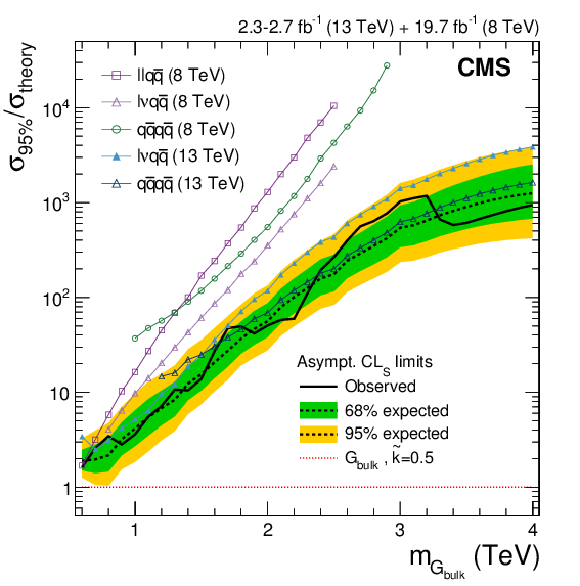
png pdf |
Figure 3:
Exclusion limits at 95% CL on the signal strength in the bulk graviton model with $\tilde{k} = $ 0.5, as a function of the resonance mass, obtained by combining the 8 and 13 TeV diboson searches. The signal strength is defined as the ratio of the excluded cross section and the theoretical prediction. The curves with symbols refer to the different inputs to the combination. The thick solid (dashed) line represents the combined observed (expected) limits. |
| Tables | |

png pdf |
Table 1:
Summary of the properties of the heavy-resonance models considered in the combination. The polarization of the produced W and Z bosons in these models is primarily longitudinal, as decays to transverse polarizations are suppressed. |

png pdf |
Table 2:
Summary of signal efficiencies in analysis channels for 2 TeV resonances in the different models under study. For analyses that define high-purity (HP) and low-purity (LP) categories, both efficiencies are quoted in the form HP/LP. Signal efficiencies are given in percent, and include the SM branching fractions of the bosons to the final state in the analysis channel, effects from detector acceptance, as well as reconstruction and selection efficiencies. Dashes indicate negligible signal contributions that are not considered in the overall combination. Channels marked with an asterisk have been reinterpreted for this combination, as described in the text later. |

png pdf |
Table 3:
Correlation across analyses of systematic uncertainties in the signal prediction affecting the event yield in the signal region and the reconstructed diboson invariant mass distribution. A ``yes'' signifies 100% correlation, and ``no'' means uncorrelated. |

png pdf |
Table 4:
Lower limits at 95% CL on the resonance masses in HVT models A and B. |

png pdf |
Table 5:
Signal cross sections in units of fb at 8 TeV center-of-mass energy. HVT model A and model B cross sections are quoted in the form $\sigma _{\text {Model A}}/\sigma _{\text {Model B}}$. |
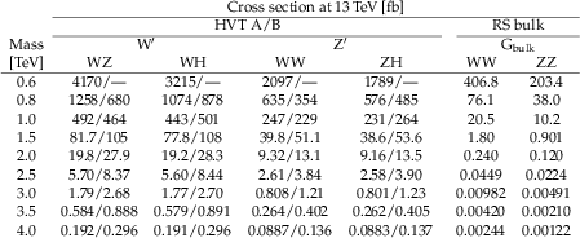
png pdf |
Table 6:
Signal cross sections in units of fb at 13 TeV center-of-mass energy. HVT model A and model B cross sections are quoted in the form $\sigma _{\text {Model A}}/\sigma _{\text {Model B}}$. |
| Summary |
| A statistical combination of searches for massive narrow resonances decaying to WW, ZZ, WZ, WH, and ZH boson pairs in the mass range 0.6-4.0 TeV has been presented. The searches are based on proton-proton collision data collected by the CMS experiment at centre-of-mass energies of 8 and 13 TeV, corresponding to integrated luminosities of 19.7 and up to 2.7 fb$^{-1}$, respectively. The results of the searches and of the combination are interpreted in the context of heavy vector singlet and triplet models predicting W' and Z' bosons decaying to WZ, WH, WW, and ZH, and a model with a bulk graviton that decays into WW and ZZ. The small excesses observed with 8 TeV data by the ATLAS and CMS experiments [21,16] at 1.8-2.0 TeV are not confirmed by the analyses performed with 13 TeV data. This is the first combined search for WW, WZ, WH, and ZH resonances and yields 95% confidence level lower limits in the heavy vector triplet model B on the masses of W' and Z' singlets at 2.3 TeV, and on a heavy vector triplet at 2.4 TeV. The limits on the production cross section of a narrow bulk graviton resonance with the curvature scale of the warped extra dimension $\tilde{k}= $ 0.5, in the mass range of 0.6 to 4.0 TeV, are the most stringent published to date. The statistical combination of VV and VH resonance searches in 12 distinct final states was found to yield a significant gain in sensitivity and therefore represents a powerful tool for future resonance searches with the large expected diboson event data sample at the LHC. |
| References | ||||
| 1 | L. Randall and R. Sundrum | A large mass hierarchy from a small extra dimension | PRL 83 (1999) 3370 | hep-ph/9905221 |
| 2 | L. Randall and R. Sundrum | An alternative to compactification | PRL 83 (1999) 4690 | hep-th/9906064 |
| 3 | B. Bellazzini, C. Cs\'aki, and J. Serra | Composite Higgses | EPJC 74 (2014) 2766 | 1401.2457 |
| 4 | R. Contino, D. Marzocca, D. Pappadopulo, and R. Rattazzi | On the effect of resonances in composite Higgs phenomenology | JHEP 10 (2011) 081 | 1109.1570 |
| 5 | D. Marzocca, M. Serone, and J. Shu | General composite Higgs models | JHEP 08 (2012) 013 | 1205.0770 |
| 6 | D. Greco and D. Liu | Hunting composite vector resonances at the LHC: naturalness facing data | JHEP 12 (2014) 126 | 1410.2883 |
| 7 | ATLAS Collaboration | Combination of searches for WW, WZ, and ZZ resonances in $ pp $ collisions at $ \sqrt{s} = $ 8 TeV with the ATLAS detector | PLB 755 (2016) 285 | 1512.05099 |
| 8 | ATLAS Collaboration | Search for production of $ WW/WZ $ resonances decaying to a lepton, neutrino and jets in $ pp $ collisions at $ \sqrt{s}= $ 8 TeV with the ATLAS detector | EPJC 75 (2015) 209 | 1503.04677 |
| 9 | ATLAS Collaboration | Search for WZ resonances in the fully leptonic channel using pp collisions at $ \sqrt{s} = $ 8 TeV with the ATLAS detector | PLB 737 (2014) 223 | 1406.4456 |
| 10 | ATLAS Collaboration | Searches for heavy diboson resonances in $ pp $ collisions at $ \sqrt{s}= $ 13 TeV with the ATLAS detector | JHEP 09 (2016) 173 | 1606.04833 |
| 11 | ATLAS Collaboration | Search for new resonances decaying to a W or Z boson and a Higgs boson in the $ \ell^+\ell^-\mathrm{b\bar{b}} $, $ \ell\nu\mathrm{b\bar{b}} $, and $ \nu\bar{\nu}\mathrm{b\bar{b}} $ channels with pp collisions at $ \sqrt{s} = $ 13 TeV with the ATLAS detector | PLB 765 (2017) 32 | 1607.05621 |
| 12 | ATLAS Collaboration | Search for a new resonance decaying to a W or Z boson and a Higgs boson in the $ \ell \ell / \ell \nu / \nu \nu + \mathrm{b\bar{b}} $ final states with the ATLAS detector | EPJC 75 (2015) 263 | 1503.08089 |
| 13 | CMS Collaboration | Search for new resonances decaying via WZ to leptons in proton-proton collisions at $ \sqrt s = $ 8 TeV | PLB 740 (2015) 83 | CMS-EXO-12-025 1407.3476 |
| 14 | CMS Collaboration | Search for massive resonances decaying into pairs of boosted bosons in semi-leptonic final states at $ \sqrt{s}= $ 8 TeV | JHEP 08 (2014) 174 | CMS-EXO-13-009 1405.3447 |
| 15 | CMS Collaboration | Search for massive resonances in dijet systems containing jets tagged as W or Z boson decays in pp collisions at $ \sqrt{s} = $ 8 TeV | JHEP 08 (2014) 173 | CMS-EXO-12-024 1405.1994 |
| 16 | CMS Collaboration | Search for massive WH resonances decaying into the $ \ell \nu \mathrm{b} \overline{\mathrm{b}} $ final state at $ \sqrt{s}= $ 8 TeV | EPJC 76 (2016) 237 | CMS-EXO-14-010 1601.06431 |
| 17 | CMS Collaboration | Search for narrow high-mass resonances in proton-proton collisions at $ \sqrt{s} = $ 8 TeV decaying to a Z and a Higgs boson | PLB 748 (2015) 255 | CMS-EXO-13-007 1502.04994 |
| 18 | CMS Collaboration | Search for a massive resonance decaying into a Higgs boson and a W or Z boson in hadronic final states in proton-proton collisions at $ \sqrt{s}= $ 8 TeV | JHEP 02 (2016) 145 | CMS-EXO-14-009 1506.01443 |
| 19 | CMS Collaboration | Search for massive resonances decaying into WW, WZ or ZZ bosons in proton-proton collisions at $ \sqrt{s} = $ 13 TeV | JHEP 03 (2017) 162 | CMS-B2G-16-004 1612.09159 |
| 20 | CMS Collaboration | Search for heavy resonances decaying into a vector boson and a Higgs boson in final states with charged leptons, neutrinos, and b quarks | PLB 768 (2017) 137 | CMS-B2G-16-003 1610.08066 |
| 21 | ATLAS Collaboration | Search for high-mass diboson resonances with boson-tagged jets in proton-proton collisions at $ \sqrt{s}= $ 8 TeV with the ATLAS detector | JHEP 12 (2015) 055 | 1506.00962 |
| 22 | D. Pappadopulo, A. Thamm, R. Torre, and A. Wulzer | Heavy vector triplets: bridging theory and data | JHEP 09 (2014) 060 | 1402.4431 |
| 23 | K. Agashe, H. Davoudiasl, G. Perez, and A. Soni | Warped gravitons at the LHC and beyond | PRD 76 (2007) 036006 | hep-ph/0701186 |
| 24 | A. L. Fitzpatrick, J. Kaplan, L. Randall, and L.-T. Wang | Searching for the Kaluza-Klein graviton in bulk RS models | JHEP 09 (2007) 013 | hep-ph/0701150 |
| 25 | O. Antipin, D. Atwood, and A. Soni | Search for RS gravitons via $ W_LW_L $ decays | PLB 666 (2008) 155 | 0711.3175 |
| 26 | C. Grojean, E. Salvioni, and R. Torre | A weakly constrained W' at the early LHC | JHEP 07 (2011) 002 | 1103.2761 |
| 27 | P. Langacker | The physics of heavy Z' gauge bosons | Rev. Mod. Phys. 81 (2009) 1199 | 0801.1345 |
| 28 | E. Salvioni, G. Villadoro, and F. Zwirner | Minimal Z' models: present bounds and early LHC reach | JHEP 11 (2009) 068 | 0909.1320 |
| 29 | CMS Collaboration | The CMS experiment at the CERN LHC | JINST 3 (2008) S08004 | CMS-00-001 |
| 30 | M. Schmaltz and D. Tucker-Smith | Little Higgs theories | Ann. Rev. Nucl. Part. Sci. 55 (2005) 229 | hep-ph/0502182 |
| 31 | N. Arkani-Hamed, A. G. Cohen, E. Katz, and A. E. Nelson | The Littlest Higgs | JHEP 07 (2002) 034 | hep-ph/0206021 |
| 32 | M. S. Chanowitz and M. K. Gaillard | The TeV physics of strongly interacting W's and Z's | NPB 261 (1985) | |
| 33 | CMS Collaboration | Search for dijet resonances in proton-proton collisions at $ \sqrt{s} = $ 13 TeV and constraints on dark matter and other models | Accepted by PLB | CMS-EXO-16-032 1611.03568 |
| 34 | CMS Collaboration | Search for narrow resonances in dilepton mass spectra in proton-proton collisions at $ \sqrt{s} = $ 13 TeV and combination with 8 TeV data | PLB 768 (2017) 57 | CMS-EXO-15-005 1609.05391 |
| 35 | CMS Collaboration | Search for high-mass diphoton resonances in proton-proton collisions at 13 TeV and combination with 8 TeV search | PLB 767 (2017) 147 | CMS-EXO-16-027 1609.02507 |
| 36 | CMS Collaboration | Performance of electron reconstruction and selection with the CMS detector in proton-proton collisions at $ \sqrt{s}= $ 8 TeV | JINST 10 (2015) P06005 | CMS-EGM-13-001 1502.02701 |
| 37 | CMS Collaboration | Performance of CMS muon reconstruction in pp collision events at $ \sqrt{s}= $ 7 TeV | JINST 7 (2012) P10002 | CMS-MUO-10-004 1206.4071 |
| 38 | CMS Collaboration | Performance of the CMS missing transverse momentum reconstruction in pp data at $ \sqrt{s} = $ 8 TeV | JINST 10 (2015) P02006 | CMS-JME-13-003 1411.0511 |
| 39 | Particle Data Group Collaboration | Review of particle physics | CPC 40 (2016) 100001 | |
| 40 | CMS Collaboration | Identification techniques for highly boosted W bosons that decay into hadrons | JHEP 12 (2014) 017 | CMS-JME-13-006 1410.4227 |
| 41 | M. Cacciari, G. P. Salam, and G. Soyez | FastJet user manual | EPJC 72 (2012) 1896 | 1111.6097 |
| 42 | M. Wobisch and T. Wengler | Hadronization corrections to jet cross sections in deep-inelastic scattering | in Proceedings of the Workshop on Monte Carlo Generators for HERA Physics, A. T. Doyle, G. Grindhammer, G. Ingelman, and H. Jung, eds Hamburg, Germany | hep-ph/9907280 |
| 43 | M. Cacciari, G. P. Salam, and G. Soyez | The anti-$ k_t $ jet clustering algorithm | JHEP 04 (2008) 063 | 0802.1189 |
| 44 | CMS Collaboration | Determination of jet energy calibration and transverse momentum resolution in CMS | JINST 6 (2011) P11002 | CMS-JME-10-011 1107.4277 |
| 45 | S. D. Ellis, C. K. Vermilion, and J. R. Walsh | Techniques for improved heavy particle searches with jet substructure | PRD 80 (2009) 051501 | 0903.5081 |
| 46 | S. D. Ellis, C. K. Vermilion, and J. R. Walsh | Recombination algorithms and jet substructure: Pruning as a tool for heavy particle searches | PRD 81 (2010) 094023 | 0912.0033 |
| 47 | J. Thaler and K. Van Tilburg | Identifying boosted objects with N-subjettiness | JHEP 03 (2011) 015 | 1011.2268 |
| 48 | CMS Collaboration | Jet algorithms performance in 13 TeV data | CMS-PAS-JME-16-003 | CMS-PAS-JME-16-003 |
| 49 | CMS Collaboration | Identification of b-quark jets with the CMS experiment | JINST 8 (2013) P04013 | CMS-BTV-12-001 1211.4462 |
| 50 | CMS Collaboration | Performance of b tagging at $ \sqrt{s}= $ 8 TeV in multijet, $ \rm{t}\overline{\rm t} $ and boosted topology events | CMS-PAS-BTV-13-001 | CMS-PAS-BTV-13-001 |
| 51 | CMS Collaboration | Identification of b quark jets at the CMS experiment in the LHC Run 2 | CMS-PAS-BTV-15-001 | CMS-PAS-BTV-15-001 |
| 52 | ATLAS and CMS Collaborations, LHC Higgs Combination Group | Procedure for the LHC Higgs boson search combination in Summer 2011 | CMS-NOTE-2011-005 | |
| 53 | G. Cowan, K. Cranmer, E. Gross, and O. Vitells | Asymptotic formulae for likelihood-based tests of new physics | EPJC 71 (2011) 1554 | 1007.1727 |
| 54 | T. Junk | Confidence level computation for combining searches with small statistics | NIMA 434 (1999) 435 | hep-ex/9902006 |
| 55 | A. L. Read | Presentation of search results: the $ CL_s $ technique | JPG 28 (2002) 2693 | |
| 56 | R. D. Ball et al. | Impact of heavy quark masses on parton distributions and LHC phenomenology | NPB 849 (2011) 296 | 1101.1300 |
| 57 | M. Cacciari et al. | The $ \mathrm{t\bar{t}} $ cross-section at 1.8 and 1.96 TeV: a study of the systematics due to parton densities and scale dependence | JHEP 04 (2004) 068 | hep-ph/0303085 |
| 58 | S. Catani, D. de Florian, M. Grazzini, and P. Nason | Soft-gluon resummation for Higgs boson production at hadron colliders | JHEP 07 (2003) 028 | hep-ph/0306211 |

|
Compact Muon Solenoid LHC, CERN |

|

|

|

|

|

|